What are the “healthy” cereal options for kids out there? As a dietitian and mom of three kids, let’s walk through what to look for when choosing nourishing breakfast cereal for your kiddos!

Much like the candy aisle, the cereal aisle is flashy and enticing with its fun cartoon characters and bright colors, quickly drawing the attention of both children and adults. I’m sure you can relate that it’s a challenge to navigate that aisle without one of your kids insisting on adding at least one or two of those shiny boxes to the shopping cart…(And by the way, you shouldn’t have to navigate these tricky topics along, that’s what the Centre for Family Nutrition is here for!)
Don’t get me wrong, there is no shame in bringing these cereals home for you and your children to enjoy! Contrary to what diet culture may have us believe, offering your kids high-sugar cereal every so often can add variety and fun to your child’s eating experience (which is important!). It also offers them a neutral and positive exposure to a food that they’ll eventually be exposed to anyway! If they have some random and calm exposures at home, they won’t likely go crazy on these foods at their friends’ house, or in private. Forbidding your child from ever having these cereals may actually negatively impact their relationship with food in the long run (more on that later).
Without further ado, let’s address the question at hand. This post will cover:
- How to talk about cereal in an anti-diet way
- How to read a nutrition facts table and ingredient list
- 20+ healthy cereals for kids
- My kid only likes sugary cereals. What do I do?
- How to bump up the protein content of your child’s favorites cereal
- Are preservatives in cereal safe for my child to eat? And more!
How to talk about cereal in an anti-diet way
First of all, before we narrow down satisfying, nutrient-dense cereal options at the grocery store, I want to address using the word “healthy”. In an attempt to combat diet culture, I encourage parents to use food-neutral language. This means that instead of calling a cereal “healthy” or “unhealthy”, simply call the cereal by its name. Frosted Flakes are called Frosted Flakes, not “sugary” or “bad”. This helps to strip food of the moralizing and judgmental labels they have been dealt by diet culture.
But why bother using food neutral language when it comes to cereal (and all food for that matter)? Shouldn’t we be teaching our kids that some foods are better than others?

Not really, and here’s why…
Kids are concrete thinkers and haven’t yet developed the ability to think in abstract terms. Consequently, when an authority figure (hello, that’s us!) uses these moralizing food labels (albeit with good intent) kids may start to believe that they are inherently “bad” or “unhealthy” for wanting to eat a cereal deemed as “too sugary”. For some kids, this can lead to feelings of guilt and shame around food, and possibly trigger an eating disorder down the road. For other kids it may cause feelings of frustration and rebellion, triggering concerning behaviours such as binging on restricted foods, sneaking food, and food hoarding.
I want to be clear when I say, that no parent is perfect and we all will make (and have made) mistakes. Myself included! Shifting our language around food may seem easy on the surface, but we all have decades of past experience around food (often highly influenced by diet culture) that influences how we relate to and think about food ourselves. I encourage you to take a deep breath and know that you are doing a good job. By reading this, you are opening your mind to feeding your child in a nourishing, pressure-free and positive way!

First, check out the ingredient list
As we move forward, I want to acknowledge that yes, some foods (and cereals) are more nutrient-dense than others. Some cereals contain a decent amount of protein, fibre and micronutrients that children need for proper growth and development. Other cereals might provide more of that “fun factor” while also serving as a source of quick, short-lasting fuel.
When looking at the ingredient list, a quick trick to note is that the first ingredient listed is always the most abundant, followed by the next most abundant ingredient and so forth. When we are looking for a nourishing, and filling breakfast option we will ideally see the following:
| WHAT TO LOOK FOR | WHAT IT LOOKS LIKE ON THE LIST | |
| Whole grains are listed first | Whole grain oat/wheat/corn/barley/rice/ quinoa etc. | |
| Sugar is not listed first, and is ideally further down the list | sucrose, glucose, fructose, maltose, dextrose, corn or rice syrups, honey, cane juice, agave nectar etc. | |
| BONUS- the cereal is fortified with vitamins and minerals | iron, calcium | |
| Extra BONUS- the cereal contains nuts/seeds which adds extra fibre and protein | Almonds, pumpkin seeds, sunflower seeds, chia seeds, flax seed, etc |
And then there’s the nutrition facts table, which outlines calories, macronutrients (carbohydrates, protein, fat), fibre, and micronutrients (vitamins and mineral) provided per serving. Here is what I would focus on.
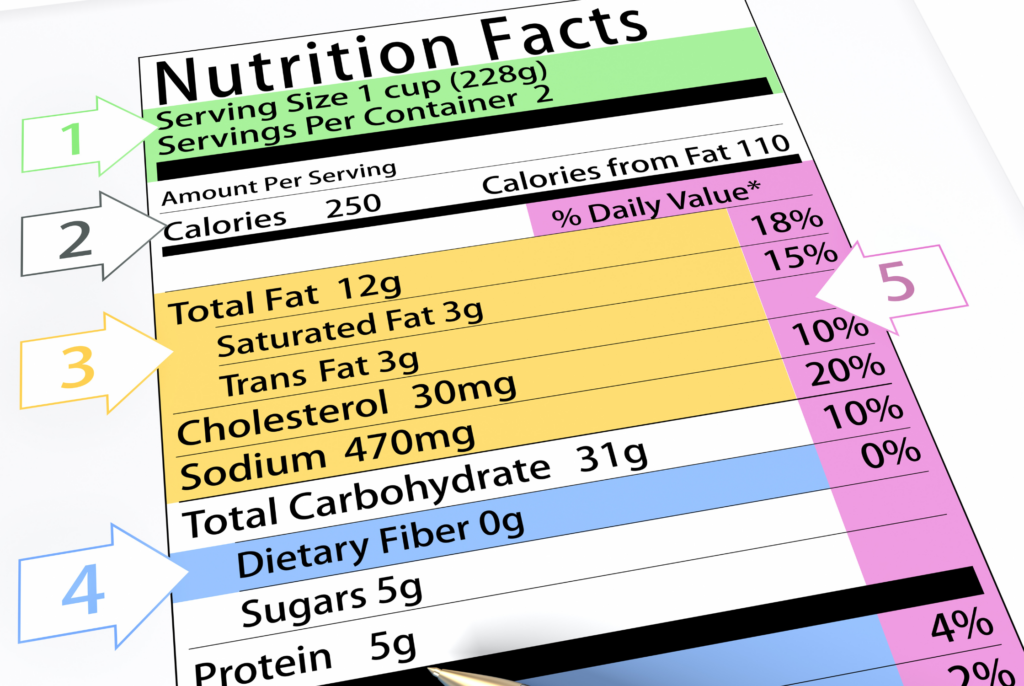
Consider fibre amount
Dietary fibre is the carbohydrate in plant foods that the body cannot digest. Even though fibre can’t be absorbed, it still provides many unique benefits to our health! Let’s dive into why fibre is important and what to look for on the nutrition facts table of a breakfast cereal:
| Benefits of Dietary Fibre | Minimum Daily Fibre Requirements for Kids | Amount of Fibre to Look for on the Nutrition Facts table |
| It adds bulk to the stool and promotes more regular bowel movements. This helps to prevent childhood constipation It provides nourishment to beneficial gut bacteria that help to improve overall health and immunity Promotes sustained energy level and fullness by slowing digestion allowing for a more stable blood sugar level | 1-3 years old: 19g 4-8 years old: 25g 9-13 years: 31g (males), 26g (females) | Aim for 3-4g of dietary fibre per 30g serving |
Consider protein content
In wellness culture, protein is definitely a popular macronutrient that gets a lot of attention, both in adult and child nutrition. Although the hype around protein can be a bit over-the-top, there is no denying that this macronutrient plays a wide array of roles in growth, development and health maintenance. Let’s dive into why protein is important and what to look for on the cereal box label:
| Benefits of Protein | Minimum Daily Protein Requirements for Kids | Amount of Protein to Look for on the Nutrient Fact Panel |
| Provides fundamental building blocks for healthy growth and development Promote repair and regeneration of tissues including muscles, skin, hair, nails and organs Supports a healthy immune system by building antibodies and immunes cells to fight off illness and infection Promotes satiation and fullness by taking longer to digest | 1-3 years old: 13g 4-8 years old: 19g 9-13 years: 34g | Aim for at least 3g of dietary protein per 30g serving |
Breakfast cereals are mostly grains and grain flour that by themselves don’t provide much protein, which is totally ok! Cereals that are higher in protein usually contain whole grains, nuts and seeds, and sometimes also have added plant protein ingredients like pea protein, chickpea and bean flours, or soy protein. Luckily, there are ways to bump of the protein of your bowl of cereal (which we will talk about later on)!
20+ healthy cereals for kids
Here is what you’ve been waiting for—my top cereal picks for kids! If you feel like none of listed cereals work for your family, that is 100% OK. This list is not definitive. Tell me in the comments what YOU would add to the list!

1. General Mills Cheerios
Cheerios are an economical option that have been a kid-favorite for decades. They provide a good source of whole grain oat fibre and are fortified to provide an excellent source of iron!
2. Post Shredded Wheat Original Spoon Size
Shredded wheat cereal is one of the simplest cereals you can find, made from just whole grain wheat and no added sugars or other ingredients. This cereal is an excellent source of fibre! As an option to help sweeten up bowl I suggest adding slices of banana, strawberries or blueberries or any favorite fried fruit!
3. Post Shreddies Original
Shreddies are made from whole grain wheat will minimal added sugar. They are an excellent source of fibre, and are fortified with iron, calcium and B vitamins!
4. Kellogg’s Original Frosted Mini Wheats
Like Shredded wheat cereal, Mini Wheats provide an excellent source of whole grain fibre, with some extra added sweetness. They are fun cereal option for kids, and are great for throwing in a baggy as a to-go snack option!
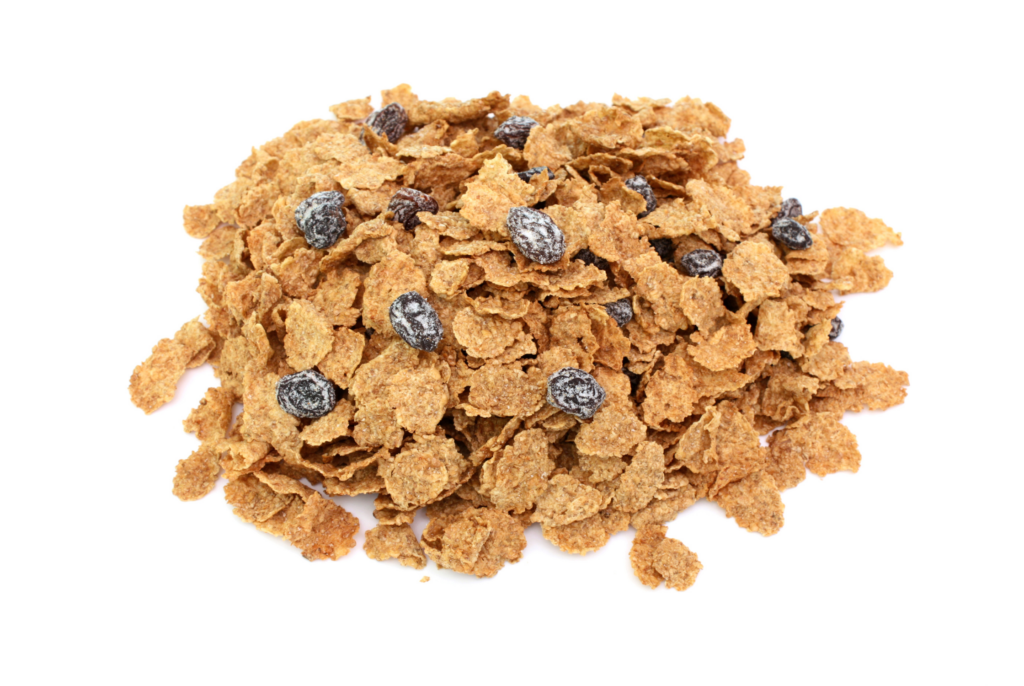
5. Kellogg’s Two Scoops Raisin Bran
Raisin Bran is very high in fibre and has a sweet kick with the raisins sprinkled in! It is also fortified with both iron and zinc, two essential nutrients that kids need for healthy growth and development.
6. Barbara’s Original Morning Oat Crunch
Morning oat crunch contains both whole grain oats, and whole grain wheat making it a great source of soluble and insoluble fibre. It is unique in that it has added pea protein, which helps raise the “staying power” of this cereal.
7. Barbara’s Original Multigrain Spoonfuls
The multigrain spoonful’s are made from both whole grain wheat and whole grain oats, providing both soluble and insoluble fibre. Powerful antioxidants (vitamin E and C) are added to maintain freshness.
8. Kashi Honey Toasted Oat
This cereal comes in heart and circle shapes making it fun for kids to eat! It contains whole grain oats and added oat hull making it a great source of fibre. The added tocopherols make it an excellent source of vitamin E, a powerful antioxidant which also helps to preserve the cereals freshness!
9. Kashi Go Lean Original
This crunchy and lightly sweet cereal is packed with protein and fibre from seven whole grains and added soy protein concentrate. This cereal is an excellent source of both iron and manganese (a mineral essential for bone and joint health as well as blood sugar regulation).
10. Kashi Go Lean Chocolate Crunch
This cereal is lightly sweetened with chocolate, providing an excellent source of both fibre and protein from whole grains and soy flakes. Add milk and banana slices to this cereal for a satisfying and delicious breakfast meal!
11. Natures Path Pumpkin Seed + Flax Granola
This pick is actually more of a granola, making it a great option to sprinkle over top of yogurt or a smoothie. Its also a perfect crunchy on-the-go snack to throw into your kid’s lunch! The pumpkin seeds and flax seeds also add extra protein, healthy fats, and iron!
12. Natures Path Flax Plus Cinnamon Flakes
This cereal is made from whole wheat, flaxseed and oats providing a diverse range of nutrients and fibre. The crunchy flakes with a hint of cinnamon is a delicious way to get a dose of the days dietary fibre in one bowl!
13. Natures Path Heritage O’s
This cereal contains 6 ancient whole grains, packing it full of essential nutrients like protein, fibre, magnesium, zinc and iron. The classic “o” shape makes this cereal fun and less intimidating for kids to eat and enjoy.
14. Nature’s Path Gluten Free Mesa Sunrise Cereal
This gluten free cereal is made with corn, and ancient grains like buckwheat, amaranth and quinoa making it relatively high in fibre compared to other gluten free cereal options. Although not fortified, this cereal does provide a source of iron.
15. Kellogg’s Special K Protein Cereal
This high protein cereal contains whole grain wheat and added soy protein isolate, helping your kids to feel full and satisfied. It is fortified with a wide range of vitamins and minerals including vitamin B12 which is essential for your kiddos brain and cognitive development. [SR4] Unfortunately, the “Special K” brand is largely rooted in diet culture, mostly promoting weight-loss for adults. It is important that we do not subscribe to this damaging narrative for the sake of both our kids and our own relationship with food. This nourishing cereal should simply be enjoyed with no strings attached.

16. Weetabix
Weetabix has a very simple ingredient list with just whole grain wheat, sugar and salt! It is also fortified with B vitamins and iron, providing essential nutrients for our kids cognitive and general growth and development.
17. Post Grape Nuts
This old classic was first developed in 1897, made from whole grain wheat and malted barley giving it is distinctive flavor and texture. It is now fortified with essential nutrients and provides an excellent source of iron, zinc, folate, and vitamin B6 (a B vitamin essential for metabolism, red blood cell formation, brain function and mood regulation)
18. Jordans Morning Muesli 4 nut medley
This delicious crunchy medley contains a variety of whole grains, chopped dates, nuts and seeds providing a diverse texture and flavor experience for your child. This cereal is packed with fibre, protein and essential fats helping to keep tummies fuller for longer. Please note that if your child is under 4 years of age, pieces of dried fruits and nuts in this cereal can pose a choking hazard.
19. Quaker Oatmeal Squares
The whole grain oats and wheat in this fortified cereal provides satisfying protein and fibre as well as essential nutrients such as iron, folate, vitamin E and potassium. The consistent square shape and texture of this cereal is predicable and comforting to kiddos who are more cautious eaters.
20. Quaker Life Multigrain Original
Life cereal is made from whole grains with a touch of sweetness that kids love. It has a light crispy texture that works well both in and out of milk. Fortified with essential nutrients this cereal is also an excellent source of iron, and B vitamins (including folate which is essential in mental health, digestive function, immune support, DNA synthesis and red blood cell production).
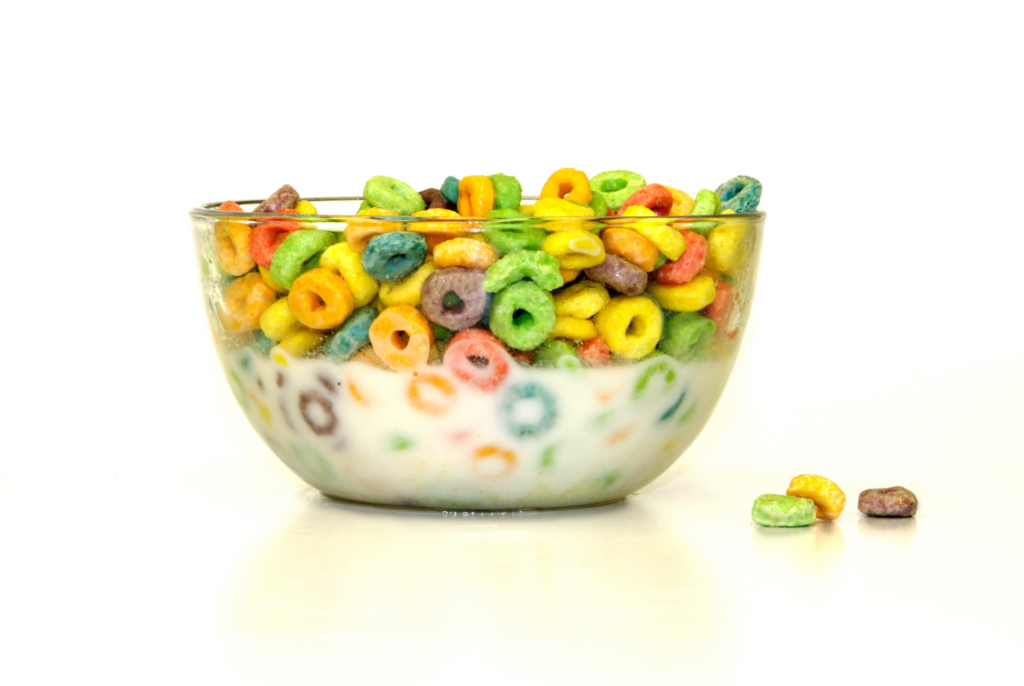
My kid only likes sugary cereals. What do I do?
Now you might be thinking “What if my kids only like the less nutrient dense “sugary kid cereals”?”. You don’t have to take these cereals away from them. Instead, serve them randomly to your kids, helping them know that these “fun” cereals are not off limits, but at the same time, they might not be served every single day for breakfast.
You can also try mixing your child’s favorite fun cereal together with a more protein and fibre rich cereal. For example, if your kiddos love Fruit Loops, try mixing in some Cheerios or Shreddies to bump up “staying power” of their bowl!
How to bump up the protein content of your child’s favorites cereal
Luckily, it is quite easy to bump up the protein amount in your child’s bowl of cereal. This provides more “staying power”, keeping them satisfied for longer. Here are some delicious ways on how to bump up the protein:
Add milk or fortified plant-based beverages
If you prefer to serve your child’s cereal the traditional way by simply adding milk, I suggest opting for a milk that contains 8g of protein per cup. Cows milk, soy milk, and protein fortified plant based milks (like the Silk Vanilla Almond & Cashew Protein milk) are good options! Unfortunately, many nut and grain-based milks (such as oat, coconut, almond, rice, hemp milk etc.) contain little to no protein per serving.

Add nuts or seeds
If you want to take it one step further after adding milk, sprinkle in some protein AND (bonus!) fibre rich nuts and seeds such chia seeds, hemp hearts, roasted pumpkin seeds, chopped walnuts and almonds etc. Please take note that some seeds, nuts and nut pieces choking hazards for kids under the age of 4 years old and should be chopped into fine almost ground like texture before they are added into the bowl of cereal.
Serve cereal over yogurt
Another option is to serve cereal over yogurt and add some fruit to create a satisfying breakfast parfait! Greek yogurt is high in protein and provides about 8-9g in only a ½ cup serving. You can also use regular yogurt which contains about 4-5g of protein per ½ cup serving.
Frequently asked questions
Aren’t breakfast cereals too processed and high in sugar to feed my kid?
As mentioned above, in order to nurture your child’s relationship with food, it is very important not to restrict or vilify these foods. This will backfire in the long run, disrupting their self-regulation of food intake, and possibly causing disordered perceptions around food and body image.
With that said, not all breakfast cereals are created equal. Some contain more whole grains, protein and fibre, providing higher nutrient density which helps fill your child’s tummy for longer. Other more “sugary” cereals provide a source of quick energy and add the “fun factor” to your child’s eating experience, helping to create positive memories around food. Conversely if these types of cereals are forbidden it can lead to negative feelings of pressure and restriction around food. You as the parent get to decide how often you serve the more “fun” cereals, in a frequency that feels right for you and your family!
Are preservatives in cereal safe for my child to eat?
Yes, they are highly regulated and are added in safe amounts to food. The preservatives added to cereal include BHT and tocopherols which are antioxidants that help to extend shelf life by keeping the cereal fresh and preventing oils from becoming rancid.
Do food dyes in cereal cause cancer?
There is currently no conclusive evidence that artificial food dyes cause cancer with the exception of Red No. 3 (or Erythrosine) in excessive amounts. This red food color is not permitted in cereals as per the Health Canada website. However, while very uncommon some food dyes may be associated with hyperactivity in sensitive children.
Interestingly, advances in technology and sourcing have made it easier for cereal manufacturers to switch to natural food colors in their products (such as beet juice extract, carrot juice extract, turmeric and spirulina). For example cereals like Post Timbits® Cereal Birthday Cake and Reese’s Puffs Cereal use only natural food colors.

Is gluten free cereal healthier?
No. Gluten-free cereal is only healthier if you have a sensitivity or allergy to gluten containing grains. Kids with celiac disease, for example, should only eat gluten free cereal to prevent health complications. If your child does not have a diagnosed allergy or sensitivity to gluten, then do not let the word “gluten free” sway you in what cereal to purchase for your child.
Is non-GMO and organic cereal healthier?
The simple answer is no. Unfortunately, there is a lot of fear surrounding conventional (which includes Genetically Modified and non-organic) foods making them seem somehow tainted compared to their organic and non-GMO counterparts. The truth is, decades of scientific research shows that both conventional and organic, non-GMO foods are equally safe and nutritious options. It is 100% up to you to decide what to buy for your family.
Is breakfast cereal a choking hazard for my child?
Breakfast cereals that contain small, hard to chew pieces in them can be a choking hazard for kids under the age of 4 years old. Nuts and seeds, dried fruit, and hard small cereal pieces often present in granola, can pose a choking risk. However, easy to chew, dissolvable cereals like Cheerios can be safe for younger kiddos that are learning to eat.
Bottom Line:
Remember, these are guidelines on how to choose a “healthy” cereal. No matter what cereal options you choose, the most important thing that your choices support your goals of feeding and nutrition in a way is realistic and sustainable for your family.
References:
- Dietary reference intakes for macronutrients – Canada.ca
- Applications of food color and bio-preservatives in the food and its effect on the human health – ScienceDirect




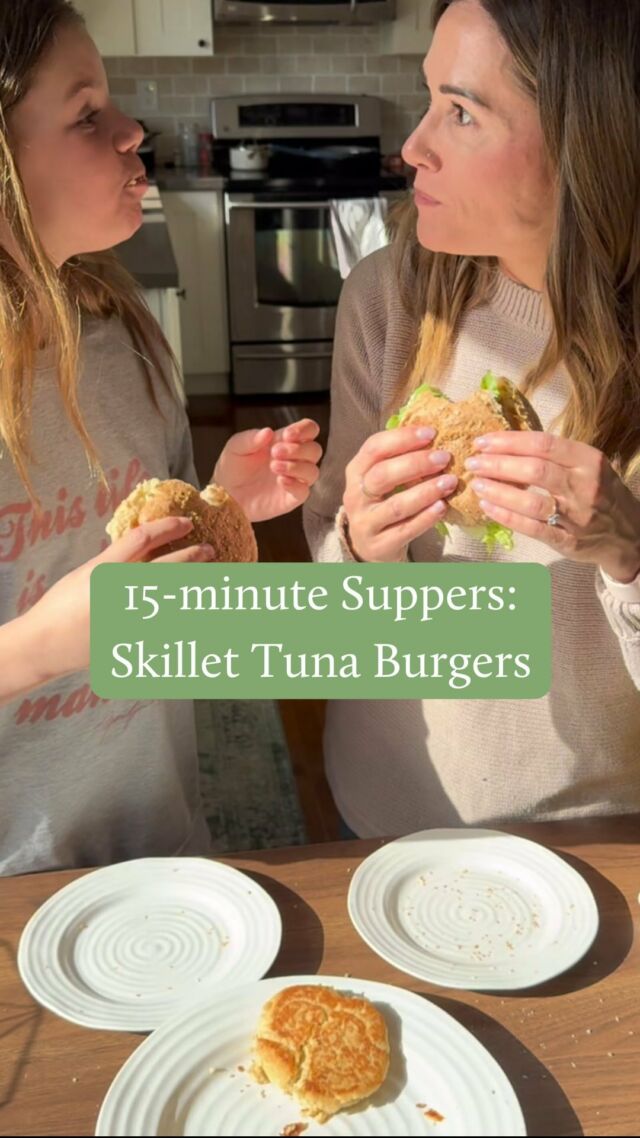
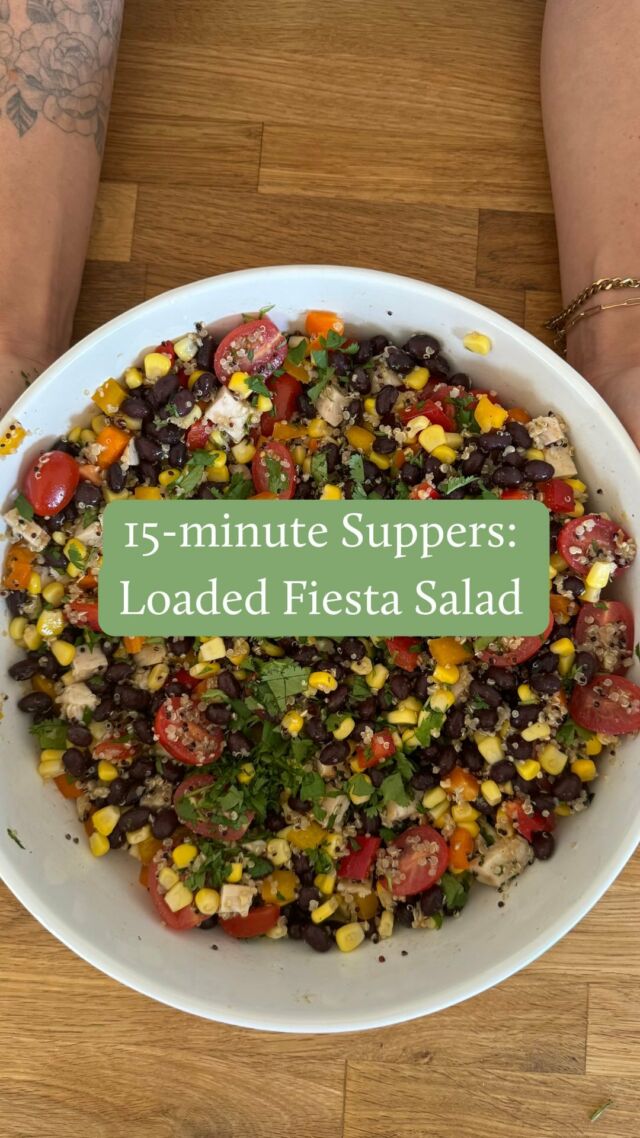



Leave a Comment